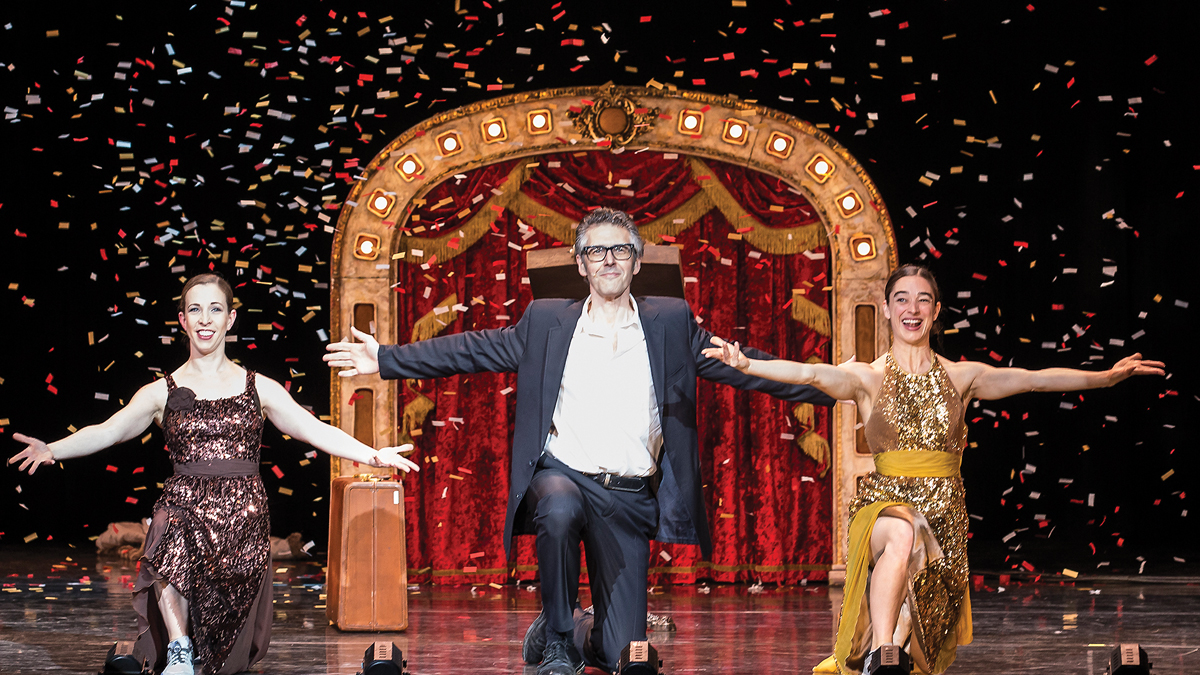“Writing about music is like dancing about architecture.” That famous axiom is supposed to illuminate the absurdity of crossing two unrelated media, but This American Life host Ira Glass is coming to Seattle to present a live stage show combining dance and radio. So all bets are off, really. As Glass explained recently by phone, Three Acts, Two Dancers, One Radio Host was born after the beloved, bespectacled radio host saw a performance by New York choreographer Monica Bill Barnes, whose work shares TAL’s sense of humor, emotional grounding, and element of surprise. Barnes, who’s always attempted to reach beyond traditional dance audiences, worked with Glass to create a hybrid show combining his journalistic storytelling with her modern dance choreography, which she performs with Anna Bass. (The trio first performed together at Carnegie Hall in 2013.)
SW:
I heard that you’ve called this show your favorite project you’ve ever been a part of—what is it about this project you love so much?
Ira Glass: It’s just completely unlikely and unnecessary. It’s something nobody wanted at all and has no right to exist. It’s a completely frivolous thing. And also, it’s a show that has everything I like in it. It feels like an episode of the radio show when it’s at its best.
You’ve always been eager to play with the forms journalism can take and the varying shapes you can mold it into. Is this project just a sort of logical or illogical extension of that drive?
Totally. In the last year, we’ve done some really different projects on the radio show. Like, we produced two musicals. One that Lin-Manuel Miranda wrote for us—he’s about to go star on Broadway with this musical he wrote called Hamilton—and another that Stephin Merritt of Magnetic Fields wrote for us. Plus we had two mini-operas, one of them by Philip Glass, my cousin. We also started this podcast that tried to invent a totally new way to tell a journalistic story, called Serial.
[Laughing] Yeah, I’ve heard of it.
And then now we have this dance. All of this is just part of the people I work with trying to do new things with journalism that we thought would be fun.
Were you nervous that such an odd gamble, pairing dance with journalism, would just fall totally flat?
Oh, yeah, of course. For a while, it wasn’t entirely clear how to make the project work. It wasn’t entirely clear how we would combine these two forms in a way that wouldn’t be totally corny. Like, there was a bunch of initial stuff we tried that we ended up killing. It was hard to figure out some moves—like, I even talk about this in the show—the first idea we attempted was the easiest. It was, like, “Well, I could tell a story, a true story, about dancers,” and Monica could invent some movement to go with it. That was obvious and I felt like of course it should be able to work.
So we did that, but what we immediately learned is that the dancers can’t just illustrate what I’m saying—it seemed really dreadfully corny, like hula or something. Like if I start talking about lava coming out of a volcano and they start pretending they are the lava using their hands or something—just really, really dumb. What we learned is, it’s almost like I have to be telling one story with the words, and they have to be doing a parallel thing that is not the same in movement. Sometimes they get laughs on what they’re doing with the dance that I’m not getting in the talking. In that number, the one I’m talking about where I actually talk about dance, Monica gets laughs on two of their entrances, it’s funny. So while I’m talking, trying to get laughs, it’s almost like they have this entirely separate relationship with the audience, and they’re all getting their own laughs.
It’s
funny you say that, because dance is often construed as this very austere discipline. It’s not really something people see for its humor.
Dance is hindered by the fact that it’s capable of great beauty. I think any art form that’s capable of great beauty, has trouble with funny. Like opera—doesn’t have a lot of great funny stuff. Think about it, is there any great classical stuff you’d classify as funny? I think there’s a certain kind of visual art that can be very funny and witty, but the type of people doing it who are aspiring towards beauty generally don’t also live in the world of funny, just because the moves are so different.
I know you got in a lot of trouble for your “Shakespeare sucks” tweet—is that lack of “classical funny” part of what made you say that?
For the record, I don’t think Shakespeare sucks. It was just a tweet. It wasn’t a verdict on one of the icons of Western culture. You know, just to be clear where I’m standing on that. Also, I think it’s kind of silly that whole episode was a thing at all.
Twitter is a silly place in general. I read that when you were researching the
This American Life
archives for stories you’d done on dance that you might be able to use for this project, you came across one you’d done on a touring Riverdance company who got bored doing the same routine every night, so they began inventing new ways to keep themselves entertained. Was this dance project partially your own reaction to feeling bored doing
TAL
every week?
No, my job is hard enough that it’s not boring. I don’t need to do anything but the radio show to stay interested in what I’m doing. It’s continually a source of fascination and difficulty and pleasure. But, but, it was definitely me going, “I think it would be really fun to try this new thing.” To work with new people whose craft is totally different than yours.
Like right now, I’m working on this project with David Byrne he invented that involves color guard, that thing where kids march around at halftime with fake rifles and sabers and throw them in the air. It’s like an artsy version of that, where these composers compete against each other—like Nelly Furtado and St. Vincent. I’ve been teamed up with a composer, Nico Muhly, to create a piece that will actually mimic one of the dance numbers in our show. It’s this piece where I interviewed Monica and Anna, the two dancers, about what they think about when they’re dancing, and you hear the audio of them talking about that as they actually perform the piece onstage.
There’s a whole class of things people can work on, an enormous range. You can do it out of boredom, or you can do it because it seems fun. In journalism, as with anything else, you need to be in it for your own amusement if it’s going to be any good. One of the things that made This American Life stand out from other shows on public radio is that we were always out for our own amusement, even with otherwise serious stories.
ksears@seattleweekly.com
THE PARAMOUNT 911 Pine St., 877-784-4849, stgpresents.org. $26.25–$75. 8 p.m. Sat., April 11.








